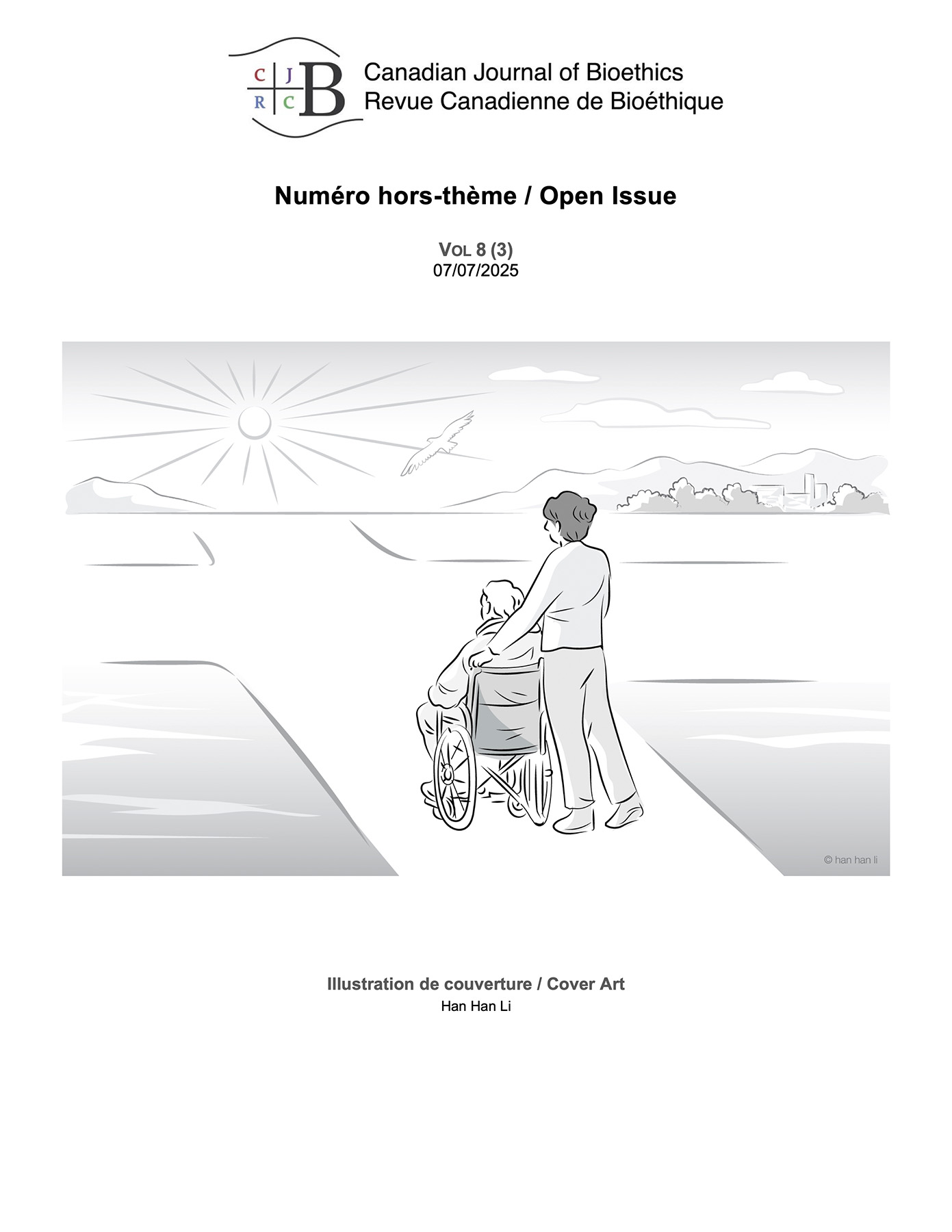Abstracts
Abstract
Do Not Resuscitate (DNR) orders are intended to respect patient autonomy and prevent unnecessary suffering when resuscitative efforts are unlikely to provide meaningful benefit. While their use is well established in end-of-life care, their application becomes ethically and procedurally complex when a patient with an existing DNR order attempts suicide. This paper explores the challenges that arise in such cases, emphasizing the need for a nuanced approach that integrates clinical assessment, considers the temporal context of suicidal intent, and upholds foundational DNR principles.
Keywords:
- DNR,
- do not resuscitate,
- medical ethics,
- end-of-life care,
- suicide
Résumé
Les injonctions de ne pas réanimer (NPR) visent à respecter l’autonomie du patient et à éviter des souffrances inutiles lorsque les efforts de réanimation ne sont pas susceptibles d’apporter un bénéfice significatif. Bien que leur utilisation soit bien établie dans les soins de fin de vie, leur application devient éthiquement et procéduralement complexe lorsqu’un patient ayant reçu une ordonnance de NPR tente de mourir par suicide. Cet article explore les défis qui se posent dans de tels cas, en soulignant la nécessité d’une approche nuancée qui intègre l’évaluation clinique, prend en compte le contexte temporel de l’intention suicidaire et respecte les principes fondamentaux de l’ordre de NPR.
Mots-clés :
- NPR,
- ne pas réanimer,
- éthique médicale,
- soins de fin de vie,
- suicide
Appendices
Bibliography
- 1. Ackermann RJ. Withholding and withdrawing life-sustaining treatment. Am Fam Physician. 2000;62(7):1555-60, 1562-1564.
- 2. American Medical Association. 5.3 Withholding or withdrawing life-sustaining treatment. AMA Code of Medical Ethics; 2019.
- 3. Zimmerman JE, Knaus WA, Sharpe SM, Anderson AS, Draper EA, Wagner DP. The use and implications of do not resuscitate orders in intensive care units. Jama. 1986;255(3):351-6.
- 4. Jonsson PV, McNamee M, Campion EW. The ‘do not resuscitate’ order. A profile of its changing use. Arch Intern Med. 1988;148(11):2373-5.
- 5. Brådvik L. Suicide risk and mental disorders. Int J Environ Res Public Health. 2018;15(9):2028.
- 6. Kawashima Y, Yonemoto N, Inagaki M, Inoue K, Kawanishi C, Yamada M. Interventions to prevent suicidal behavior and ideation for patients with cancer: A systematic review. Gen Hosp Psychiatry. 2019;60:98-110.
- 7. DeCou CR, Comtois KA, Landes SJ. Dialectical behavior therapy is effective for the treatment of suicidal behavior: a meta-analysis. Behav Ther. 2019;50(1):60-72.
- 8. Wilkinson ST, Trujillo Diaz D, Rupp ZW, et al. Pharmacological and somatic treatment effects on suicide in adults: a systematic review and meta-analysis. Depress Anxiety. 2022;39(2):100-12.
- 9. Huang BY, Chen HP, Wang Y, Deng YT, Yi TW, Jiang Y. The do-not-resuscitate order for terminal cancer patients in mainland China: A retrospective study. Medicine (Baltimore). 2018;97(18):e0588.
- 10. Huang RS, Kam A. Humanism in Canadian medicine: from the Rockies to the Atlantic. Can Med Educ J. 2024;15(2):97-98
- 11. Levin TT, Li Y, Weiner JS, Lewis F, Bartell A, Piercy J, Kissane DW. How do-not-resuscitate orders are utilized in cancer patients: timing relative to death and communication-training implications. Palliat Support Care. 2008;6(4):341-8.
- 12. Nemetz E, Huang RS. Ethical implications of end-of-life decisions. Can J Bioeth. 2024;7(2-3):172-74.
- 13. Choi JY, Kim SW, Yoon SJ, Kang MG, Kim KI, Kim CH. Impact of frailty on do-not-resuscitate orders and healthcare transitions among elderly Koreans with pneumonia. Clin Interv Aging. 2018;13:2237-45.
- 14. Boyd K, Teres D, Rapoport J, Lemeshow S. The relationship between age and the use of DNR orders in critical care patients. Evidence for age discrimination. Arch Intern Med. 1996;156(16):1821-6.
- 15. Government of Ontario. Health Care Consent Act. S.O. 1996, c. 2, Sched. A.
- 16. Henman MP. Suicidal patients with a do-not-resuscitate order. J Emerg Med. 2017;52(1):117-20.

